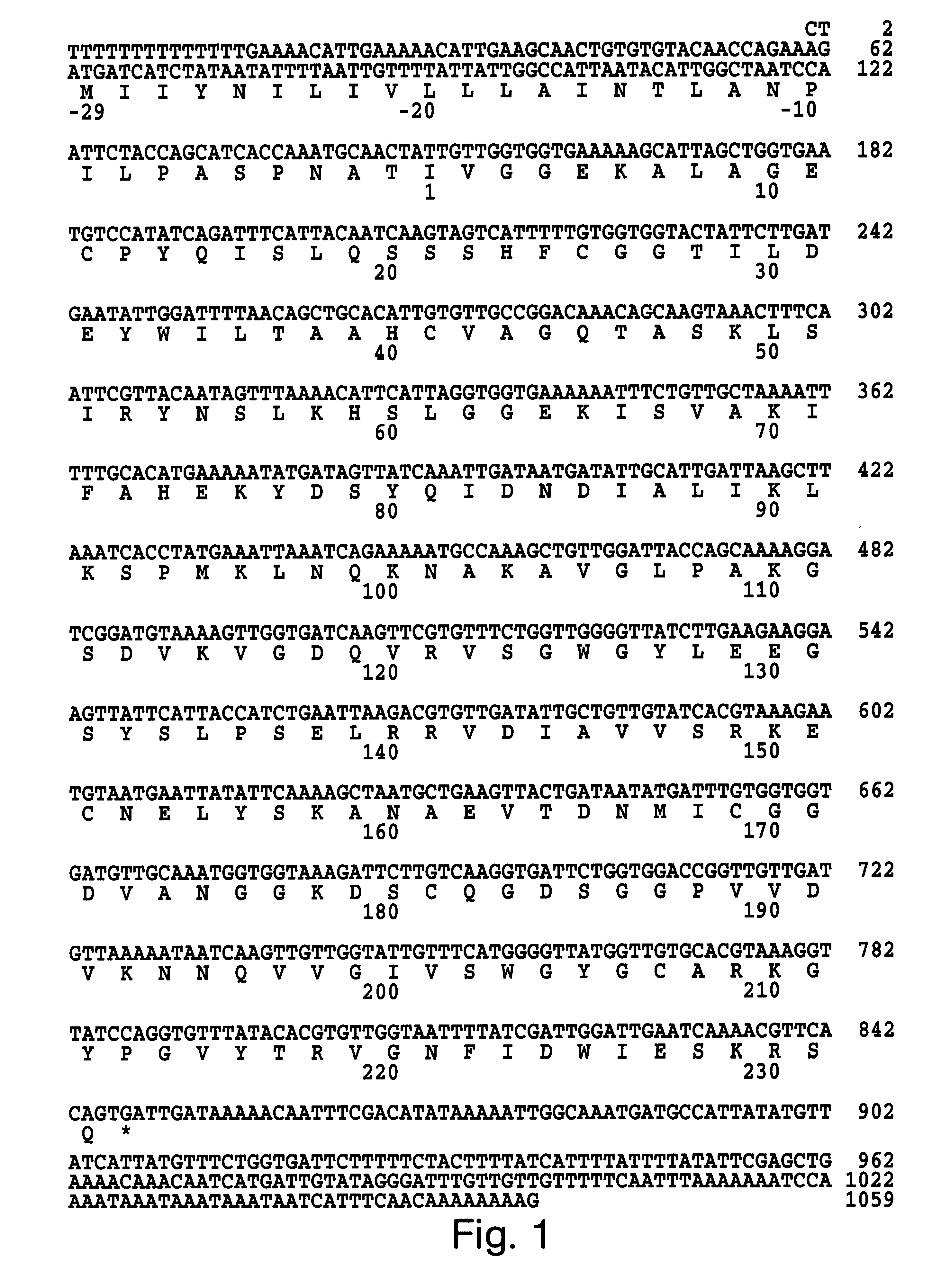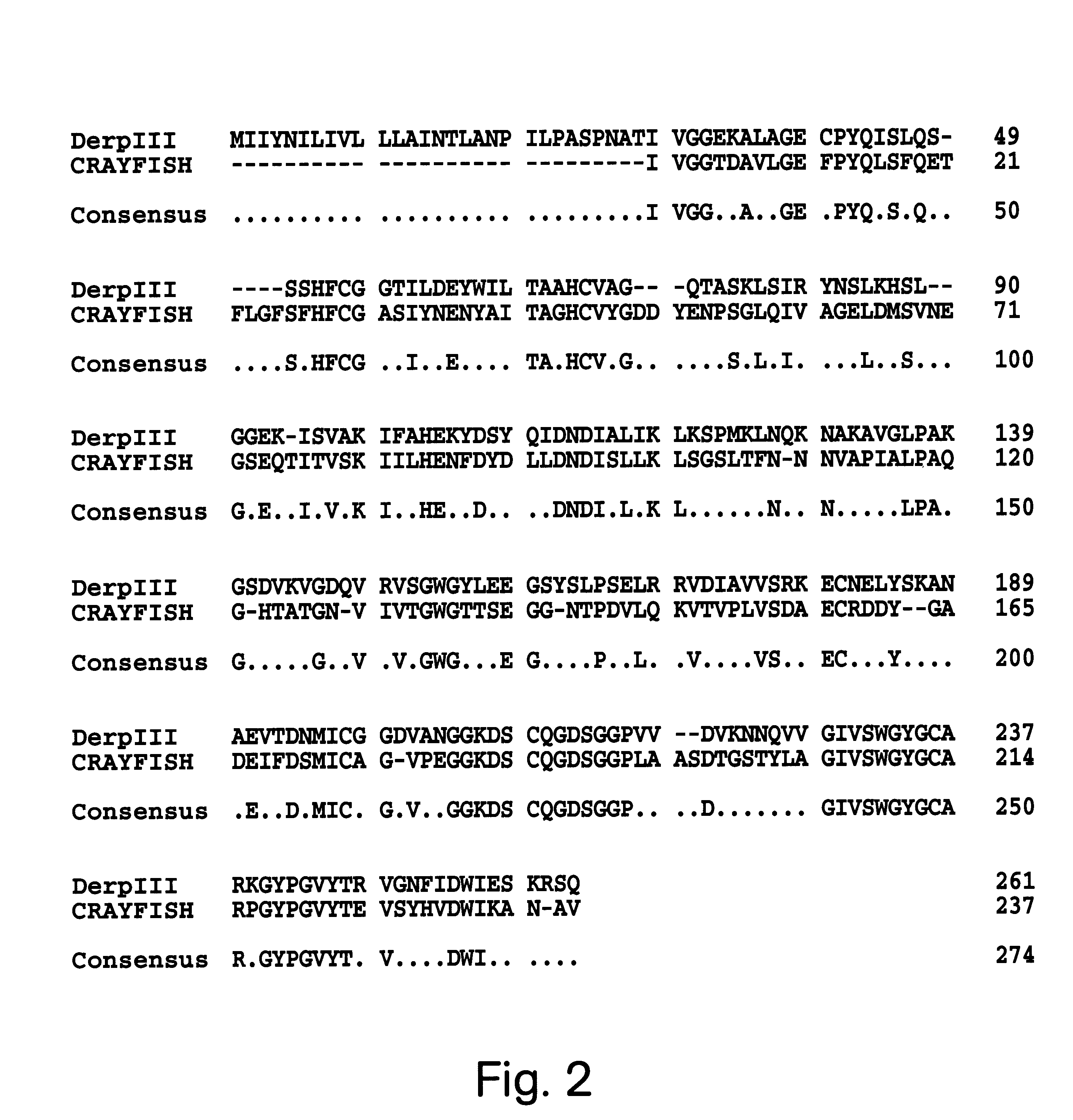Nucleic acids encoding a house dust mite allergen, Der p III, and uses therefor
a technology of nucleic acids and allergens, applied in the field of nucleic acids encoding house dust mite allergens, der p iii, can solve problems such as potential anaphylaxis during treatment, and achieve the effect of fewer anticipated side effects
- Summary
- Abstract
- Description
- Claims
- Application Information
AI Technical Summary
Benefits of technology
Problems solved by technology
Method used
Image
Examples
example 1
of the Native Group III Allergens
The protein isolation procedure produced a Der p III sample which ran as a doublet with molecular weights 30 and 28k when analyzed by SDS-PAGE. Both bands reacted with polyclonal mouse anti-Der f III in accord with the interspecies cross-reactivity previously reported (Thomas et al., Exp. Appl. Acarol. (1992) 16:153-164). Der f III isolated from a 5A12 monoclonal antibody (Heymann et al. J. Allergy Clin. Immun. (1989):1055-1067) column exhibited similar characteristics. Using the o-pthalaldehyde to eliminate the contaminating protein sequences, the N-terminal sequencing of both native Der p III and Der f III corrected and extended the known Der p III sequence and extended the Der f III sequence. The Der p III N-terminal sequence was extended to IVGGEKALAGQSPYQISLQSSSHFSGGTIL (SEQ ID NO:16). The Der f III N-terminal sequence was extended to IVGGVKAKAGDSPYQISLQSSSHFXGGSILD (SEQ ID NO:15). Comparison of the sequence data published by Stewart et al. (Imm...
example 2
of Recombinant Der p III
The protein sequence information obtained as described in Example 1 was used in conjunction with the preferred codon usage data (Table 1) to construct two oligonucleotides probes. These oligonucleotides were designed to hybridize to nucleotide residues 159-196 and to residues 688-648 of the Der p III clone (FIG. 2). Only clones which hybridized strongly with both probes were isolated from the .lambda. gt10 cDNA library. The resulting nucleotide sequence for the P3WS1 clone and the deduced amino acid sequence is shown in FIG. 1. The complete nucleotide sequence was 1059 bp in length. This includes a 5' non-coding region of 62bp, a 211 bp 3' untranslated region and an open reading frame of 786 bp with a stop codon (TGA) at nucleotide residues 846-848. There is no poly A tail but there does appear to be a polyadenylation signal (AATAAA). The open reading frame encodes a protein which includes a 29 amino acid pre-pro region and starting at the N-terminal isoleuci...
example 3
n and Purification of Recombinant Der p III
A complementary DNA insert encoding Der p III (FIG. 1) was digested with EcoRI and inserted into pUC19. To remove the non-translated 5' sequence as well as part of the putative hydrophobic leader, the cDNA was cleaved with MscI and an EcoRI linker was added. Subsequently, the truncated Der p III fragment was EcoRI digested and subcloned into the expression vector pET11d (Studier et al., Gene Expression Technology: Methods in Enzymology 185, Academic Press, San Diego, Calif. (1990) 60-89). The sequence and reading frame were verified by DNA sequencing. The Der p III coding sequence encompassed residue 13 to the stop codon (see FIG. 1). The expression vector pET11d Der p III was transformed into the E. coli host strain BL21(DE3) and selected on plates containing 150 .mu.g / ml ampicillin (Studier et al., Gene Expression Technology: Methods in Enzymology 185, Academic Press, San Diego, Calif. (1990) 60-89). A single transformant colony was grown...
PUM
| Property | Measurement | Unit |
|---|---|---|
| Tm | aaaaa | aaaaa |
| temperature | aaaaa | aaaaa |
| temperature | aaaaa | aaaaa |
Abstract
Description
Claims
Application Information
 Login to View More
Login to View More - R&D
- Intellectual Property
- Life Sciences
- Materials
- Tech Scout
- Unparalleled Data Quality
- Higher Quality Content
- 60% Fewer Hallucinations
Browse by: Latest US Patents, China's latest patents, Technical Efficacy Thesaurus, Application Domain, Technology Topic, Popular Technical Reports.
© 2025 PatSnap. All rights reserved.Legal|Privacy policy|Modern Slavery Act Transparency Statement|Sitemap|About US| Contact US: help@patsnap.com


